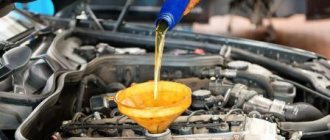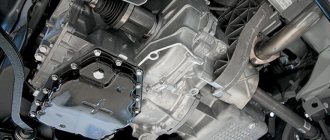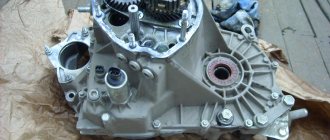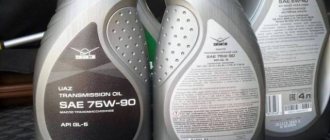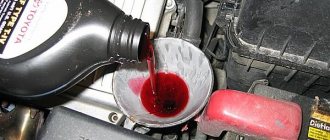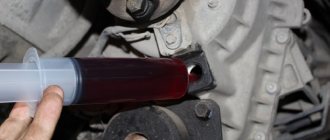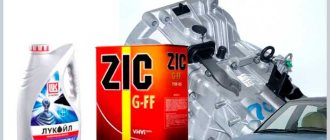One of the types of transmissions that can be found on a car is a manual transmission. Proper care helps to extend its service life.
What does manual transmission maintenance involve? To prevent the mechanics from losing their properties prematurely, the car owner must check the oil level in the box.
When to change the oil in a manual transmission?
The quality of oil in any gearbox must comply with the prescribed technical standards. If it has lost its properties, the car owner will face the following problems:
- difficulty changing gears;
- when turning on the speed, extraneous knocks and hums are noted;
- Instead of one gear, another is activated.
It is possible to carry out both partial and complete changes of transmission oil. A complete replacement can be carried out after 60,000 km. You can carry out this procedure either independently or resort to the services of a service center, whose competence includes installing new oil filters, spark plugs, and flushing the manual transmission when changing the oil.
Oil selection parameters
There are a number of criteria that must be taken into account in order to choose an oil with the optimal viscosity for your gasoline or diesel engine.
It is important to use products that are labeled to meet the vehicle manufacturer’s approvals.
We choose only labeled motor oil
It is not recommended to experiment and fill your engine with the first option you come across. Otherwise, this may negatively affect its operation and lead to the most unfavorable consequences, including major repairs.
Viscosity
This parameter is key when selecting engine oil for any vehicle and period of operation. However, not everyone understands what this term means. In simple terms, this is the ability of fuels and lubricants to maintain their properties at a certain temperature. We are talking about the following parameters:
- lubrication of rubbing elements;
- reducing friction force;
- reducing fuel consumption.
It is very important that all these properties are perfectly preserved not only at positive temperatures, but also at negative temperatures. Viscosity parameters are indicated by all manufacturers on the label
The SAE system is used for this.
Classification of motor oils according to SAE. For example, the packaging indicates a combination of synthetics 5w30 or 5w40. The number “5” indicates the viscosity of the oil at negative temperatures, and the second number at positive values.
It is important to know that this is an index, not a temperature indicator.
If you are wondering what viscosity oil is best for winter with very low temperatures, you should give preference to a lubricant that has a synthetic base.
API classification of oils - table
Turnability and pumpability
These are two more important criteria that are directly dependent on viscosity
You should also pay attention to them when faced with the choice of oil for use in winter. If you don’t know which oil to fill in in winter: synthetic or semi-synthetic, keep in mind that the first option allows the engine to start easier
The best choice of oils in the box is synthetics
Such a product has sufficient fluidity; it is pumped faster through the oil channels, minimizing the negative consequences of a cold start at low temperatures.
If you fill in synthetic oil in winter, you can see that the engine will start easier. This is due to the fact that a liquid with such a consistency will not create much resistance to the crankshaft, and will allow it to start easily even in severe frost.
If you don’t know what type of oil to fill in during the cold season, you should read the owner’s manual to understand what recommendations the manufacturer gives. This will allow you to understand how to choose the right consumables for your car so that it does not fail even in extreme operating conditions.
Instructions for using engine oil in the winter season
Is it possible to use mineral oil?
The composition of such fuels and lubricants includes ingredients of natural and artificial origin. If the list of components contains only petroleum products, this product has a mineral base.
Due to the high content of components isolated from fuel oil, soot and soot appear on the internal elements. This negatively affects the life of the engine and its performance characteristics. In cold weather, such a product will easily thicken and therefore it is not recommended to use it in winter.
Coked engine from using mineral oil
The mineral water should be changed after 5–7 thousand kilometers. If the vehicle is operated in active mode, the oil life expires much faster.
All-season
The multi-grade engine oil that has appeared on the market is the best option only if the car is operated in regions with a temperate climate.
Does the box need to be washed?
Flushing the gearbox is a necessary procedure that is carried out when the transmission fluid is replaced. It allows you to completely remove all dirt from the box.
What is the advantage of performing a flush? First of all, this is the removal of wear products. Accumulating in the oil and settling on the internal elements of the gearbox, they contribute to their rapid failure. Flushing improves the circulation of transmission fluid and extends the service life of various box seals.
As a rule, a special liquid that contains the addition of detergents acts as a flushing oil. It is capable of effectively cleaning every element of the gearbox.
Gearbox cleaning products
Recently, the “5-minute” flushing fluid has become a very popular gearbox flush. It is intended for flushing the engine oil system and transmission components. Washing effectively removes even varnish deposits on surfaces. It is used in the traditional way, as described above. LUXE flushing oil is designed for the same purpose. This oil is made from high quality mineral oil with the addition of sufficient additives designed to provide maximum surface cleaning. It can even dissolve some wear products of parts. Low viscosity facilitates high-quality penetration of the flush into the most remote corners of the gearbox.
At the present stage, only additives are increasingly used, without the use of mineral oil as a base. An example of such a product is the Automatik Getriebe-Reiniger automatic transmission cleaner from Liqui Moly. This is one of the few washes from a foreign manufacturer. This professional flush is for servicing automatic transmissions. Using it will help you get rid of sudden gear changes. Allows you to remove a wide variety of contaminants from the box. A cleaned gearbox will last much longer.
The use of this tool is as simplified as possible. The contents of the container are poured into a preheated automatic box. The substance contained there should be enough for 9 liters of oil. While holding the brake pedal, you need to play with the gearbox mode shift knob for 10 minutes. After this flushing, you can add fresh oil.
There are more and more such washes on the market, although not all car enthusiasts are unanimous on the need for their use. Many drivers with many years of experience consider flushing the gearbox with mineral oil as a completely unnecessary undertaking, which will not bring any results other than wasting money and time. In their opinion, a good new oil can easily cope with the remnants of the old lubricant.
The use of flushing liquid does not cause any controversy only in one case - when a low-quality oil product gets into the box. In this case, the gearbox must be washed.
Another large category of drivers have absolute confidence in the mineral oil filled in by the manufacturer and do not want to replace it under any circumstances. How many people - so many opinions, so whether or not to flush the gearbox is up to each driver to decide for himself.
How to flush the gearbox before adding new oil?
Before changing the oil, to ensure greater fuel fluidity, it is necessary to warm up the manual transmission. Next, you should park the car on a flat surface, for example, on an overpass. After this, you can begin the procedure for replacing and flushing the mechanics.
The main stages of manual transmission flushing:
- Access to the box opens.
- An empty container is installed under the gearbox where the fluid will drain. The container volume depends on the amount of fuel used in the box.
- The filler plug is loosened.
- The drain plug is unscrewed.
- The drain plug must be cleaned.
- As soon as the liquid is drained, the cap is screwed on.
- Flushing oil is added through the filler hole in exactly the same amount as the volume the manual transmission is designed for.
- It is necessary to let the engine idle for about 15 minutes.
- Next, the flushing fluid is drained and new fuel is added.
In this case, you should stock up on rags, a set of keys, screwdrivers, and a funnel with a hose.
Flushing the engine when changing the oil: good or bad?
sh: 1: --format=html: not found
This question continues to haunt the minds of car owners. Let's figure it out.
Then they poured oil into the engine, the thickest oil that could be found. The cylinders were not the best and knocked slightly. This was compensated for by the thickness of the lubricant; the engine ran surprisingly quietly.
Erich Maria Remarque
How to flush the gearbox when changing the oil?
LIQUI MOLY Getriebe-Reiniger
For each brand of car, an oil of the appropriate class is used, which is recommended by the manufacturer.
To increase the service life of the gearbox system, it is recommended to use LIQUI MOLY Getriebe-Reiniger flushing oil. It is suitable for the mechanic's box and allows you to quickly and effectively remove any dirt from the gearbox. This type of flushing is neutral to oil seals and rubber seals.
The flushing liquid helps prevent the formation of corrosion deposits inside the box.
How to use LAVR
How to wash the transmission with your own hands? This is easy to do if you use LAUREL.
- The flushing liquid is poured into the used motor oil through the oil filler neck (one hundred milliliters of product per liter of oil product).
- By means of an overpass or jacks, the front wheels of the car are raised above the ground.
- The engine starts, transmission modes change randomly for ten minutes.
- Upon completion of washing, the used oil product and the washing agent are drained, and fresh motor oil is poured in.
Transmission maintenance is not included in the car service regulations. If the car was purchased secondhand, there is no guarantee that all necessary procedures were carried out on time and correctly. Any service center will tell you that gearbox lubricant changes its color and consistency during operation. This is due to oxidation and accumulation of wear products. These changes affect the functioning of the transmission.
Hardware washing of the automatic transmission
TOTEK
It is possible to carry out flushing both on cars that are equipped with a manual transmission, and on cars where an automatic transmission acts as a transmission. During this procedure, contaminants are removed from the machine, channels and solenoids are cleaned. As a result, the operation of the checkpoint is normalized. When washing the machine, it is necessary to replace the filter associated with the box. At the service station, this procedure is performed by technicians using a special apparatus, adhering to the following algorithm:
- Work begins with a warm car.
- The fluid is drained from the gearbox.
- The pipes of the device are connected to the cooling system of the box.
- The engine starts for about 20 minutes.
- The pan is dismantled after the flushing oil has been drained into it, or the drain plug is unscrewed, from where the fuel flows into a previously prepared container.
- The filter and pan gasket are changed.
- The pallet must be cleaned of accumulated wear products.
- New transmission fuel of the required volume is poured.
- The engine starts and the gears are changed several times.
- Finally, the amount of transmission oil is checked. If it has decreased, it is worth adding it.
After this, it is recommended to operate the car in a gentle mode and drive with minimal load on the vehicle system.
For automatic transmissions, the use of TOTEK fluid is suitable. It allows you to wash the hidden cavities of the box and remove stubborn dirt. If flushing does not bring the desired results, a comprehensive diagnosis of the gearbox should be performed.
Thus, the remains of old oil inside the gearbox negatively affect its performance, which reduces the comfort of using the gearbox. To ensure its smooth functioning, this device should be flushed periodically.
Causes of manual transmission contamination
The most common reason for contamination and the need to flush the gearbox is water getting into the mechanism. The manual transmission is leaking. It must be in contact with the atmosphere to avoid the formation of excess pressure or vacuum due to temperature changes.
The valve, which provides air inflow or outflow (breather), is located at the top of the box. Under normal operating conditions, it works normally, but if the car gets into a deep puddle, water enters the breather. The box cools sharply, and the transmission oil turns into an emulsion. If such a liquid is not replaced in time, the process of hydrolysis begins, that is, “saponification” of the oil. At the same time, it loses all its lubricating and cleaning properties.
Transmission fluid can also cause contamination of the manual transmission if it overheats for a long time. This occurs when driving for a long time at high speed or in off-road conditions, or when towing a heavy load. Due to unacceptably high temperatures, the oil in the box begins to “cook”, forming something like an ointment.
Deposits in the manual transmission oil pan, as well as on other parts of the unit, are caused by oxidized oil if oil change intervals are not observed.
Flushing the automatic transmission torque converter
It is almost impossible to do this procedure on your own. Flushing the torque converter is only possible if you cut the donut. Without opening, washing is ineffective and will not have any noticeable effect.
Opening the torque converter
If the housing is sawn, then all the elements of the torque converter immediately become accessible - you can visually assess the scale of the problem. After troubleshooting, cleaning begins. Thoroughly wash the turbine blades and elements in the clutch mechanism.
The cleaning procedure is simple - the part is immersed in a container with a high concentration cleaning solution and the carbon deposits are washed off manually. After cleaning, all dismantled elements are installed back, and the torque converter housing is welded. Next, the system is checked for leaks.
Flushing the transmission radiator
The automatic transmission gets very hot during operation, and therefore it has a cooling system with a separate heat exchanger. If the latter is not dirty, it will cope with heat removal without any problems. But as soon as a layer of dirt accumulates in the channels, the box overheats.
Cleaning the heat exchanger inside
The radiator is washed together with the gearbox before changing the oil. The most effective method is a mixture of alcohol and aqueous solvents. The service station has a washing stand for this purpose. But in a garage you can use a circulation pump yourself. How it all happens:
- remove the automatic transmission oil pipes;
- a hose coming from the pump is connected to the inlet pipe;
- the second pipe is inserted into a container suitable for washing;
- the receiving container is filled with solvent;
- The liquid is pumped into the radiator through the “return” hose (that is, it should pour out from the supply part).
- turn on the pump for up to 15 minutes.
Next, the solvent is drained. If it turns out to be very dirty, the procedure is repeated. If instead of a solvent you use a cleaning agent in aerosol cans, cleaning is carried out according to the same scheme - from supply to return. You need to pour in so much chemical until a clean solution comes out of the return part.
When washing is completed, be sure to dry the heat exchanger - this can be conveniently done with an air compressor. Next, about a liter of working fluid is poured into the automatic transmission radiator, checking it for throughput. If the liquid does not come out well, such a radiator needs to be changed - no amount of cleaning will help it.
External plaque
Important! The radiator must be clean not only inside, but also outside. We carefully wash away all the dust under low pressure of water so as not to damage the honeycombs.
Standard method
In this case, the automatic transmission will be flushed with an oil change. What to do:
- .Drain the old oil. It is advisable to warm up the box (it is enough to drive 2-3 kilometers). The oil becomes more liquid and drains much faster.
- Find the drain hole on the bottom of the crankcase and unscrew the drain plug - this is a shortened bolt with a recessed head. Wait. until the liquid stops dripping.
- Remove the automatic transmission pan. Caution: Remember that the oil is still hot. The tray should be thoroughly washed from the outside as well as from the inside. It is recommended to degrease and wipe its surface dry.
- To flush the automatic transmission, prepare a pump, hoses of sufficient length and a suitable container. Connect the hoses to the cooling system of the box, start the engine. Washing takes from ten minutes to half an hour, depending on the degree of contamination of the box.
- After cleaning is completed, replace the oil filter and crankcase gasket. The filter is most often located at the bottom (near the valve) and is easily installed after removing the crankcase. The filter is attached to different automatic transmissions in different ways - from latches to bolt-on mounts. It is better to install the gasket on the sealant.
- Reinstall the tray.
- Add fresh oil.
Filling with new ATP fluid
Important! You need to pour exactly as much oil into the box as was drained before. Remember that both underfilling and overfilling are harmful to automatic transmissions.
- Check the level on the dipstick - it should be between minimum and maximum.
- Start and warm up the engine, take a short drive;
- Check the oil level, add if necessary. Also check for any leaks around the box. If they are not there, the replacement can be considered successful.
You can work according to a different scheme. Instead of oil, regular diesel fuel is poured into the automatic transmission. Then start the engine, let it run for 10–15 minutes and drain the liquid. If clean diesel fuel comes out, stop washing. If it is dirty, then cleaning with diesel fuel continues again with a new portion being poured. But experts do not recommend using dimexide - it is very aggressive towards friction clutches.
Types of cleaning agents
Today, the “five-minute” is very popular. It is intended for washing the lubricating complex of the engine and transmission parts, and removes varnish formations well. It is also worth mentioning the “LUX” washing. It is made from high-quality mineral water, to which additives are added to completely clean the parts. Low viscosity ensures rapid penetration of the product into all areas of the transmission.
In addition, there are additives that can be used without the main fluid. In Russia, the “Automatic Getrib-Ranger” from “Liqui Moli” is widespread. This is a flushing agent from a foreign manufacturer, which is used in automatic transmissions.
This wash is very easy to use. Pour the contents of the container into the heated transmission. Holding the brake pedal, change the gearbox gears for ten minutes. After this, apply new lubricant.
There are more and more such funds. Experienced motorists believe that there is no need to flush the transmission. They believe that fresh motor oil can flush the gearbox itself.
The use of flushing agents does not cause controversy only when a foreign substance penetrates into the unit. Then washing must be carried out without fail.
The flushing procedure is quite simple, however, if you have recently started driving your own car or are simply not confident in your abilities, contact a specialized service center, whose employees will do everything for you.
A car is a complex unit consisting of many components, elements and parts. One of these components is a manual transmission, the correct operation of which requires not only compliance with operating rules, but also timely and high-quality maintenance.
Maintenance of a manual transmission consists of checking the oil level in the box, partial or complete oil change, flushing the manual transmission (if necessary), timely repairs, adjustments, etc. Next, we will look at when and why you need to flush the manual transmission before changing the oil.
Read in this article
How does the flushing fluid work?
When replacing the lubricant, it can be very difficult to eliminate the remaining used gearbox oil. Mixing different petroleum products is undesirable. It is necessary to remove any remaining grease by flushing the gearbox. Flushing oil neutralizes the acidic environment that forms when using the machine.
Before replacing consumables, let the engine run a little. The heated oil is quickly drained. After draining the used lubricant, pour gearbox flushing agent into the unit. Let the engine idle again. Twenty minutes will be enough to clean a manual/automatic gearbox. Drain the spent flush and add lubricant.
Gearbox diagram
Is automatic transmission flushing necessary? Cleaning agents are almost never used abroad, which is why there are no products from Castrol or Shell in retail outlets. These manufacturers believe that if you follow all the maintenance rules, there will simply be no reason to flush the automatic transmission/manual transmission. You don’t have to wash the gearbox if:
- the car was just purchased at a car dealership;
- you fill the unit with high-quality lubricant;
- The oil is regularly replaced and maintenance intervals are observed.
How to wash automatic transmission parts?
Removable parts
wash
well in aviation kerosene or gasoline.
After which it is necessary to blow out all channels with compressed air, replace all gaskets and filters with new elements. The washing is completed and you can assemble the automatic transmission
and install it in place. After installation, new oil is poured into the box.
Interesting materials:
What is the normal heart rate? What is the normal heart rate at 30 years old? What is the normal resting heart rate? What is your resting heart rate? What is the normal heart rate during sleep? What is the gas mileage of the Prius? What is the fuel consumption of the Volvo XC90? What is the headphone jack? What connector does Samsung a50 have? What region is 017?

